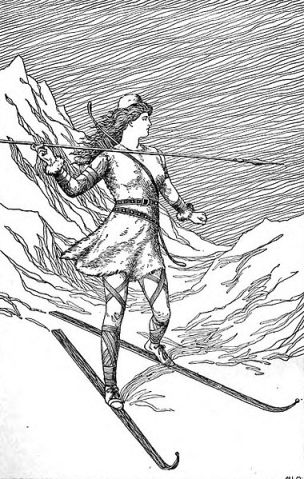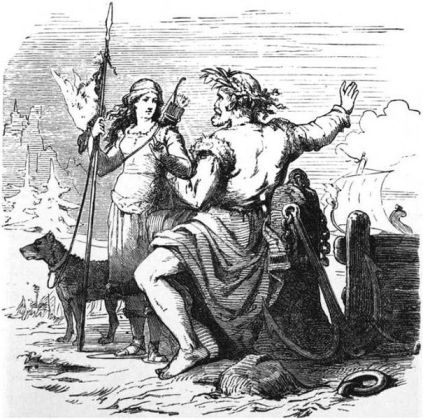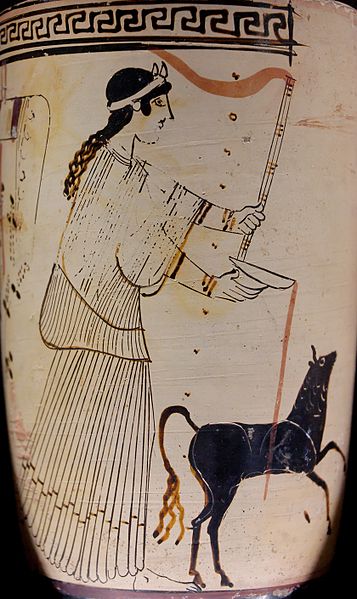This is the story of Skadi, a fierce jötun giantess who became the Aesir goddess of winter and skiing. Touching upon values like honor, retribution and reparation she represents core principles from the Viking Age. Being Norwegian I heard about Skadi at a young age, seeing as she was so closely associated with skiing. Norwegians are said to be born with skis on our feet, and from a young age we’d hear about the Birkebeiners and Skadi.
Like many of the Aesir gods of Norse mythology, Skadi shows that it was the allegiance to a tribe more than anything else that defined who you were. Having been born to a jötun father, and an unknown mother, she still ends up a Vanir (or Aesir) goddess through marriage. Personally I always found this fluidity fascinating, putting tribe above all else.
Name and Etymology
So, who exactly is Skadi? Her name is thought to be derived from Old Norse “skaði,” which means “damage” or “harm,” stemming from the Proto-Germanic *skaþô and Proto-Indo-European *(s)keh₁t- (“damage, harm”). I also want to mention that the Norwegian word even today for injury is “skade”.
She is sometimes also called Öndurguð or Öndurdís , which are Old Norse for ‘ski god’ or ‘ski dís’ respectively. No wonder she is a winter goddess closely associated with both skis and snowshoes.
This etymology hints at her fierce nature. Skadi is often associated with winter, mountains, and hunting – a true embodiment of the cold and wild Scandinavian landscape. The linguistic connections to Old Norse, Middle English, and even Proto-Indo-European words further reinforce her association with these themes.
I will come back to this later, but interestingly it is Skadi, fitting with her name, that in punishment for Loki’s many transgressions, ties a venomous snake over his head that drips poison on him.
Skadi’s Background and Origins

Skadi hails from Jötunheimr, home to the Jötnar. While often seen as enemies of the gods, they also intermingle and sometimes even marry one another. This ties in with basically most of the Aesir being half or quarter jötun themselves.
Skadi’s father is Thjazi, a notorious jötun who plays a significant role in Old Norse mythology. Thjazi is known for forcing Loki into helping him to kidnap the goddess Idunn, who guards the apples of youth. This is then triggering a series of events that ultimately lead to Thjazi’s own death. Skadi’s mother, however, remains a mystery. This could be seen as adding to Skadi’s enigmatic allure, while it is fair to assume she was a giantess with similar domains and attributes.
Interestingly, when picking a husband, Skadi ends up with the Vanir Njord. His son Freyr is also married to a jötun turned goddess, namely Gerdr known from the poem Skirnismal.
Thjazi’s Death and Skadi’s Quest for Retribution
When Thjazi crossed paths with the gods, things turned sour, ultimately leading to his death. It all began when Thjazi, in the form of an eagle, kidnapped the goddess Idun and her apples of youth. The gods, realizing they were rapidly aging without the magical apples, devised a plan to rescue Idun.
Loki, the trickster god, played a crucial role in Thjazi’s downfall. He transformed himself into a falcon, rescued Idun, and led Thjazi on a high-speed chase back to Asgard, the realm of the gods. The gods, waiting in ambush, set a fire that engulfed Thjazi’s wings, causing him to crash to the ground and meet his demise.
Skadi, grieving and enraged over her father’s death, donned her armor and set out on a quest for retribution. This aspect of her story emphasizes the importance of blood vengeance and personal honor in Viking Age culture. In those times, avenging a family member’s death was considered a sacred duty, and Skadi’s determination to seek justice for her father exemplifies this value.
Skadi’s Negotiations and Marriage to Njord
Upon arriving in Asgard, Skadi demanded compensation for her father’s death and a husband from among the gods. The gods agreed to her terms, offering her a choice of husbands based solely on the appearance of their feet. Skadi, hoping to choose the beautiful god Baldr, instead unknowingly selected Njord, the god of the sea and wealth.

Their marriage symbolized the union of opposing elements – the sea and the mountains. While Skadi preferred the snowy peaks and icy wilderness, Njord was more at home near the shore and the ocean. The couple tried to find a compromise, but ultimately, they decided to live apart, highlighting the balance of power between gods and giants, as well as the natural tension between opposing forces.
Play Fun Norse Quiz
Is this article making you even more curious about Norse gods and goddesses? You can satisfy your curiosity by playing a fun Norse mythology quiz. This way, you can test your knowledge about Norse gods and goddesses, as well as fill in some gaps. Good luck and have fun playing!
Do you want to learn more about the magical and powerful Jötunn? Then test your knowledge with this fun quiz game!
Don’t forget to try our other games as well!
Skadi and Ullr – Parallels and Theories
Another interesting aspect of Skadi’s story is her connection to Ullr, the god of skiing and hunting. Both Skadi and Ullr share similar domains and attributes, and some scholars have even suggested that they might have a shared origin or represent syncretism in Old Norse religion, where different deities merge into one.
The similarities between Skadi and Ullr could indicate a common ancestry or a regional variation in worship. It’s possible that Skadi and Ullr were once the same deity or were worshiped as a divine pair, representing the harsh Scandinavian winter and the activities associated with it.
Skadi Wife of Odin
Another fascinating reference to Skadi is found in the Heimskringla saga Ynglingasaga. In it, which is not really focused on mythology, Skadi is mentioned in passing. Then she is said to be the wife of none other than Odin. According to the short mention, they even had a number of children.
This is another example of how much we have all lost through the passing of time. It probably didn’t help that Christians for a couple of hundred years were intent on burning books about heathenry.
Skadi and Artemis: A Cross-Cultural Comparison
When going into Skadi’s story and the role she has, there are many intriguing parallels with the Greek goddess Artemis. Both figures share several similarities, highlighting common themes and archetypes in world mythology.

Both Skadi and Artemis are linked to the wilderness and animals, representing untamed aspects of nature and the resourcefulness necessary for survival in harsh environments. Moreover, they are both masters with the bow and arrow and sadly unlucky or unwilling in marriage. They also share archetypal features, such as their strong independence, and challenging traditional gender roles in their respective societies.
Differences borne out of culture
Despite striking similarities, Skadi and Artemis have notable differences. I feel Skadi’s story emphasizes Viking Age values of honor and retribution whereas Artemis’ tale focuses on her protective role. Skadi is a jötun giantess who becomes a goddess by marriage, while Artemis is a Greek goddess, daughter to Zeus, the ruler of the Olympians.
By examining their similarities and differences, we gain a deeper understanding of the human experience and values transcending cultural boundaries. Their stories resonate with audiences across time and space, reflecting universal truths about strength, independence, and our connection to the natural world.
Wrapping up on Skadi
In conclusion, Skadi’s story offers a fascinating insight into Old Norse mythology and the values of the Viking Age. From her quest for retribution to her complex relationships with the gods and her fellow giants, Skadi’s tale is rich with symbolism and meaning. Her enduring influence in modern times is a testament to the power and relevance of her story, which continues to captivate and inspire audiences today. So, the next time you find yourself in a snowy landscape, remember the fierce jötun giantess Skadi and her indomitable spirit!
FAQs about Skadi
Skadi is a jötun giantess, known for her fierce nature and association with winter, mountains, and hunting. Her story is deeply rooted in Viking Age values, such as honor, retribution, and strength.
Skadi’s name likely comes from the Old Norse word “skaði,” meaning “damage” or “harm.” This etymology emphasizes her ferocity and connection to the harsh Scandinavian landscape.
As a jötun giantess, Skadi is part of the complex relationship between gods and giants in Norse mythology. However, she marries Njord, the god of the sea, demonstrating the delicate balance of power between these two groups.
Skadi sought retribution in Asgard after the gods killed her father, Thjazi. Her journey highlights the importance of personal honor and blood vengeance in Viking Age culture.
Skadi’s marriage to Njord symbolizes the union of opposing elements, such as the sea and mountains. Their relationship also represents the balance of power between gods and giants.
Skadi shares several similarities with Artemis, such as their connection to nature, hunting, and independence. Comparing their stories highlights common themes and archetypes across different mythologies.
Sources:
Snorri Sturluson, Gylfaginning
Snorri Sturluson, Skáldskaparmál
Poetic Edda poems; Skírnismál, Lokasenna and Grimnismál
Featured Image Credit: W.G. Collingwood (1854 – 1932), Public domain, via Wikimedia Commons
